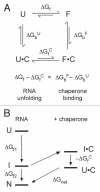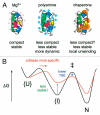Taming free energy landscapes with RNA chaperones
- PMID: 21045544
- PMCID: PMC3073327
- DOI: 10.4161/rna.7.6.13615
Taming free energy landscapes with RNA chaperones
Abstract
Many non-coding RNAs fold into complex three-dimensional structures, yet the self-assembly of RNA structure is hampered by mispairing, weak tertiary interactions, electrostatic barriers, and the frequent requirement that the 5' and 3' ends of the transcript interact. This rugged free energy landscape for RNA folding means that some RNA molecules in a population rapidly form their native structure, while many others become kinetically trapped in misfolded conformations. Transient binding of RNA chaperone proteins destabilize misfolded intermediates and lower the transition states between conformations, producing a smoother landscape that increases the rate of folding and the probability that a molecule will find the native structure. DEAD-box proteins couple the chemical potential of ATP hydrolysis with repetitive cycles of RNA binding and release, expanding the range of conditions under which they can refold RNA structures.
Figures




Similar articles
-
Generalized iterative annealing model for the action of RNA chaperones.J Chem Phys. 2013 Sep 28;139(12):121924. doi: 10.1063/1.4818594. J Chem Phys. 2013. PMID: 24089736
-
Iterative annealing mechanism explains the functions of the GroEL and RNA chaperones.Protein Sci. 2020 Feb;29(2):360-377. doi: 10.1002/pro.3795. Epub 2019 Dec 23. Protein Sci. 2020. PMID: 31800116 Free PMC article. Review.
-
Kinetic redistribution of native and misfolded RNAs by a DEAD-box chaperone.Nature. 2007 Oct 25;449(7165):1014-8. doi: 10.1038/nature06235. Nature. 2007. PMID: 17960235 Free PMC article.
-
Recent insights on RNA folding mechanisms from catalytic RNA.Cell Mol Life Sci. 2000 May;57(5):796-808. doi: 10.1007/s000180050042. Cell Mol Life Sci. 2000. PMID: 10892344 Free PMC article. Review.
-
A collapsed state functions to self-chaperone RNA folding into a native ribonucleoprotein complex.Nat Struct Biol. 2001 Feb;8(2):135-40. doi: 10.1038/84124. Nat Struct Biol. 2001. PMID: 11175902
Cited by
-
A guanosine-centric mechanism for RNA chaperone function.Science. 2013 Apr 12;340(6129):190-5. doi: 10.1126/science.1230715. Epub 2013 Mar 7. Science. 2013. PMID: 23470731 Free PMC article.
-
The brace for a growing scaffold: Mss116 protein promotes RNA folding by stabilizing an early assembly intermediate.J Mol Biol. 2012 Sep 21;422(3):347-65. doi: 10.1016/j.jmb.2012.05.037. Epub 2012 Jun 13. J Mol Biol. 2012. PMID: 22705286 Free PMC article.
-
Insights into the mechanisms of RNA secondary structure destabilization by the HIV-1 nucleocapsid protein.RNA. 2016 Apr;22(4):506-17. doi: 10.1261/rna.054445.115. Epub 2016 Jan 29. RNA. 2016. PMID: 26826129 Free PMC article.
-
Putting It All Together: The Roles of Ribosomal Proteins in Nucleolar Stages of 60S Ribosomal Assembly in the Yeast Saccharomyces cerevisiae.Biomolecules. 2024 Aug 9;14(8):975. doi: 10.3390/biom14080975. Biomolecules. 2024. PMID: 39199362 Free PMC article. Review.
-
Moderate activity of RNA chaperone maximizes the yield of self-spliced pre-RNA in vivo.Proc Natl Acad Sci U S A. 2022 Dec 6;119(49):e2209422119. doi: 10.1073/pnas.2209422119. Epub 2022 Nov 28. Proc Natl Acad Sci U S A. 2022. PMID: 36442111 Free PMC article.
References
-
- Herschlag D. RNA chaperones and the RNA folding problem. J Biol Chem. 1995;270:77–79. - PubMed
-
- Thirumalai D, Hyeon C. RNA and protein folding: common themes and variations. Biochemistry. 2005;44:4957–4970. - PubMed
-
- Weeks KM. Protein-facilitated RNA folding. Curr Opin Struct Biol. 1997;7:336–342. - PubMed
-
- Rajkowitsch L, Chen D, Stampfl S, Semrad K, Waldsich C, Mayer O, et al. RNA chaperones, RNA annealers and RNA helicases. RNA Biol. 2007;4:118–130. - PubMed
Publication types
MeSH terms
Substances
Grants and funding
LinkOut - more resources
Full Text Sources
